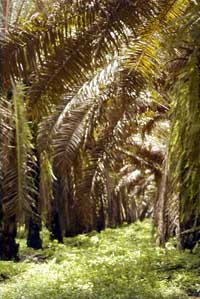
• Tell Others
|
Online Resources • Shopping • Weather • News • Exchange Rates • Translation Service • Tides • Time & Date • Surf Reports • Water Temps • Wave Heights • Satellite Images • Links • Phone Numbers • Zooming Maps |
|
• Contact Us • Newsletter |
Working the African Palm Fields
The Quepos banana plantations are long gone, having been replaced in the 1940's by hearty African palms. The African palms produce a palm oil kernel, also known as an oil date, that contains a rich oil used around the world in products ranging from lipstick to industrial lubricants.
| 1800's | African palm seeds (elaeis guineensis) are first brought to Brazil with the slave trade. |
| 1920's | African palm seeds are brought to Central America, arriving in Guatemala from Sierra Leone. |
| 1940's | Chiquita begins experimenting with African palms in the Quepos area in response to a blight of Panama banana disease. |
| 1960's | Panama banana disease is overcome through hybridization and the banana industry builds around Costa Rica's eastern coast. |
| 1970's | The palm oil industry prospers on Costa Rica's western coast. |
| 1990's | Chiquita sells their palm oil business to private investors in 1995, including more than 14,000 hectares of African palms planted throughout Costa Rica. |

African palms can live over for 200 years. They are pollinated by the wind, and until very recently, the best seeds were gathered, stored and used for new plantings. Now workers almost always plant hybrid clones. The new clones produce much shorter trees, making the palms easier to maintain and the fruit easier to cut. The first fruit pods are ready to cut when the palms are about three years old. After about 20 years, the older non-hybrid variety of palms became too tall for the workers and much less productive. Workers are systematically replanting the plantations with the short hybrid clones and are killing the old, tall trees by injecting them with a giant syringe containing a potent herbicide. The hearty new clones, planted in the shade of the mature palms well before their deadly herbicidal injections, can then receive full sunlight as the old palms die and are removed.
The plantation work is highly specialized. Certain workers are in charge of keeping the base of each tree cleared using machetes or herbicides. This keeps the snake population at bay and allows the leaf cutters (these are not ants, these are real people) unfettered access to the trees. The leaf cutters trim the lower leaves so the fruit cutters can have easy access once the fruit is mature. The fruit cutters harvest the large fruit pods when they are a bright orange-red. As the pod crashes to the ground several of the dates break free and scatter. Different workers come along and search for these individual dates and collect them in bags. This is among the most dangerous of jobs due to the high incidence of poisonous snakebites, especially among inexperienced women and children who often perform this function. The strongest and healthiest of the workers throw the large pods into trailers being towed by tractors or oxen. Some plantation workers focus on fertilizing the vast plantings, while many others work in local crude processing plants. The palm oil is used domestically in such local products as "Numar" margarine, and is shipped to points around the world for use in cosmetics, food, candies, lubricants and many more products.
A Most Lucrative and Favorable Deal
In the old days, before palm trees replaced the bananas here, rail lines criss-crossed the banana plantations. Rail cars were used for carrying the bananas to boats docked at the Quepos pier. When the banana production declined because of the Panama banana blight, local farmers re-worked their plantations to ready them for introducing the new palms and dug the never-before-needed irrigation canals that were sometimes the size of a small river. The rails from the abandoned banana rail lines were recycled by the U.S. Army Corps of Engineers to construct numerous bridges across the irrigation canals so Chiquita could transport the heavy pods to their processing plants.
A Day with David
David relaxes with his family in the shade of a giant almond tree everyday after work. They are sitting on a log in the front yard chatting about the poisonous snake, an aggressive fer-de-lance, that David killed this morning while working alongside his father. Now eighteen years old, David began working in the palm plantations when he was eight collecting the dates that break free when the pods are cut. After ten years on the job he is a leaf cutter like his father and older brothers. David began the day at five o'clock this morning. He quickly ate a serving of rice and beans, then jumped on his bike for the hour-long ride deep into the palms where the leaf cutters have been assigned to trim leaves. After hours of intense cutting, punctuated by the dramatic killing of the fer-de-lance replete with hollers, whistles and half an hour of examining the fangs, the official counter finally arrived on horseback to count the leaves. David and his family are paid twice monthly based on the number of leaves they cut. Their family of eleven lives in a small company home. "The evenings used to be boring until we saved enough for a television," David muses. "Sometimes we cannot afford to pay the electric bill so we light candles at night and play with the children."